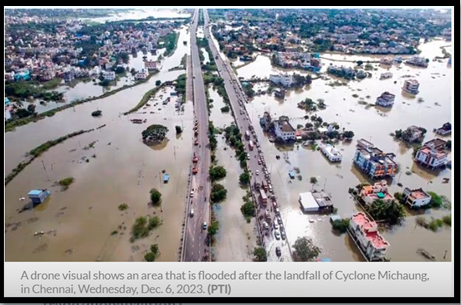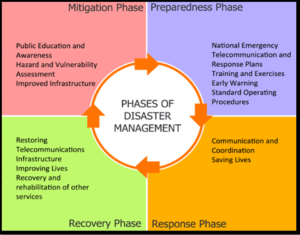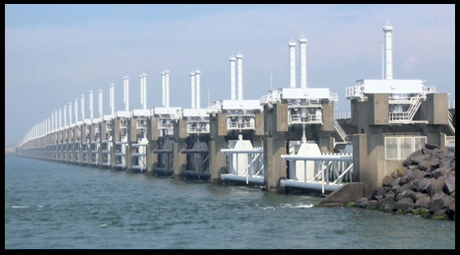TURBULENCE IN SOUTH
Syllabus:
- GS3 : Disaster and Disaster Management
Why in the News?
- December has ushered in turmoil for Tamil Nadu, with the aftermath of Cyclone Michaung in the north and torrential rainfall wreaking havoc in the south.
- This unprecedented turbulence sparks crucial contemplation on weather forecasting and disaster preparedness effectiveness.
Source: Mint
Unusual Heavy Rainfall
- Attributed to upper air circulation, a rare weather event unfolded with 39 places experiencing “extremely heavy rainfall,” surpassing 21 cm in just 24 hours.
- This unexpected deluge posed a significant threat to the affected regions.
- Kayalpattinam in Thoothukudi district recorded an unprecedented 95 cm of rainfall.
- Eight other locations also reported over 50 cm during the same period, breaking records and causing widespread concern.
Freak Occurrence in Monsoon
- The entire weather episode was deemed a freak occurrence within the ongoing northeast monsoon.
- Such abnormal weather patterns raised questions about climate unpredictability and the region’s vulnerability to extreme events.
Impact of Cyclone Michaung
Tamirabharani River’s Unusual Flow
- Tamirabharani river witnessed an extraordinary flow of 1.5 lakh cubic feet per second (cusecs), marking an unusual and rare occurrence.
- This surge in water levels posed a significant threat to the surrounding areas.
Human Loss and Infrastructure Damage
- Unfortunately, the cyclone resulted in the tragic loss of at least 17 lives, Over 41,000 individuals were forcibly evacuated from their residences, primarily in Tamil Nadu and Andhra Pradesh.
Transportation Disruption
- Halting of a train with approximately 800 passengers traveling from Tiruchendur to Chennai at the Srivaikuntam station.
Power Disruptions
- To prevent electrocution risks, power supply was intentionally disrupted in flood-affected areas in Tamil Nadu and Andhra Pradesh, contributing to widespread power outages.
Coastal Flooding
- Coastal villages and towns experienced inundation, causing substantial harm to homes and agricultural lands due to rising floodwaters.
Industrial Sector Submersion
- Chennai’s industrial sector faced severe losses as numerous units were submerged, resulting in considerable financial setbacks.
Livestock Losses
- The cyclone also led to the loss of livestock, further exacerbating economic challenges for the affected communities.
Assessing Gaps in Michaung Response
Meteorological Warnings vs. Actual Impact
- The recent weather event in Tamil Nadu prompts questions about the effectiveness of weather forecasting and preparedness.
- While the Meteorological Department issued warnings of “very heavy to extremely heavy” rain from December 14, the actual enormity of the rainfall caught the state by surprise, leading to concerns about the accuracy of the forecasts.
Source: Researchgate
Limitations in Forecasting Technology
- The country’s weather forecasting system faces limitations in predicting exact rainfall amounts with precise locations.
- Despite advancements, the technology has not reached a point where such detailed predictions can be consistently made.
- This highlights the need for ongoing efforts within the scientific community to enhance forecasting precision.
Interdepartmental Coordination
- The event underscores the importance of closer coordination between different government departments and agencies.
- A lack of synergy between the Meteorology department and the Railways, for example, led to disruptions in train services.
- Proactive collaboration rather than reactive measures is essential to ensure a more cohesive response to such weather-related challenges.
Building Resilience for Future Cyclones
Enhanced Early Warning Systems
- Invest in cutting-edge technology and a multi-hazard network, akin to Cuba’s Sistema de Alerta Temprana (SAT), ensuring timely and accurate warnings.
- This includes utilizing radars, sensors, and diverse communication channels for effective outreach.
Nature-Based Solutions
- Follow Bangladesh’s lead by investing in nature-basedsolutions like mangrove buffer zones.
- Strategic planting of mangroves around cyclone shelters can significantly reduce wave height, providing a natural defense against storm surges.
Community Preparedness
- Foster community resilience through comprehensive disaster education programs, following Japan’s “Saigai Kyoiku.”
- Such initiatives raise awareness, impart preparedness skills, and empower local leadership, contributing to effective risk reduction.
Emergency Response Excellence
- Improve emergency response and resource management with a centralized system like Singapore’s National Emergency Preparedness System (NEPS).
- Efficient coordination, rapid deployment, and strategic resource pre-positioning minimize response time and maximize effectiveness.
Infrastructure Resilience Model
- Strengthen infrastructure resilience inspired by the Netherlands’ Delta Works.
- Combine seawalls, dykes, and surge barriers to create a comprehensive defense against flooding, showcasing the effectiveness of innovative engineering solutions.
Source: Britannica
Climate-Resilient Recovery
- Build back better with climate adaptation measures, as seen in Fiji’s Relocation and Seawall Project.
- This involves relocating vulnerable communities inland and constructing resilient seawalls, ensuring sustainable livelihoods and protecting against future cyclones.
International Collaboration Programme
- Foster international cooperation and knowledge sharing inspired by the World Meteorological Organization’s (WMO) Tropical Cyclone Programme.
- Collaborate on research, forecasting, and disaster preparedness globally, sharing best practices and technologies.
The recent turbulence in South India underscores the unpredictable nature of weather events and the need for improved disaster preparedness. As Tamil Nadu copes with the aftermath, fostering better coordination among government agencies, investing in advanced forecasting, and promoting a collaborative approach are crucial steps toward minimizing future disasters’ impact and ensuring community well-being.
| What is Cyclone?
· A cyclone is a large-scale weather system characterized by strong winds revolving around a central low-pressure area. · Depending on their location, cyclones are referred to as hurricanes, typhoons, or tropical cyclones. Formation Process · Warm Ocean Waters: Cyclones form over warm ocean waters (usually above 26.5°C or 80°F), where the ocean’s heat and moisture serve as the energy source for their development. · Evaporation and Condensation: The warm ocean water evaporates, releasing latent heat into the atmosphere. As the warm, moist air rises, it cools, and water vapor condenses into clouds. · Coriolis Effect: Earth’s rotation induces the Coriolis effect, causing the developing storm system to spin. · In the Northern Hemisphere, cyclones rotate counter clockwise, while in the Southern Hemisphere, they rotate clockwise. · Eye Formation: As the storm intensifies, a well-defined eye forms at the center, surrounded by the eyewall, a region of intense thunderstorms. · Mature Cyclone: The cyclone reaches its peak strength with strong winds and heavy rainfall. It can span hundreds of kilometers and poses a significant threat to coastal areas |
Source:The Hindu
https://www.britannica.com/event/Delta-Works
Mains Practice Question
Discuss the recent weather-related challenges in Tamil Nadu and the impact on the southern districts. Analyze the response of government agencies and propose measures for better coordination during such disasters.

 Source: Mint
Source: Mint Source: Researchgate
Source: Researchgate Source: Britannica
Source: Britannica

